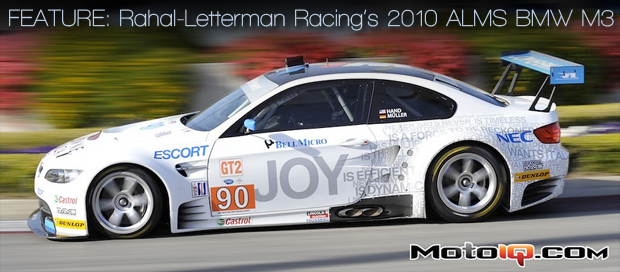,

The brakes on the M3 are typical racing stuff–huge AP racing shape optimized billet calipers, six piston in the front and 4 piston rear. The calipers are monoblock in design meaning they are forged from a single billet and shape optimized–all extra material is CNC machined away until the minimum amount to maintain stiffness remains. The brakes are fed cool air via carbon ducts.
 |
 |
 |
| The AP brake system uses huge 380mm iron 2 piece floating front rotors. The rear rotors are impressively large 355mm parts. Six piston monoblock forged shape optimized calipers are used in the front with 4 piston calipers in the rear. An AP pedal assembly uses AP master cylinders and a balance bar. The fine proportioning is handled electronically. Project Mu brake pads reportedly work very well compared to other pads the team has tested. |
The rotors are full floating two piece with alloy hats and iron friction surfaces, 380mm in diameter front and 355mm rear. Project Mu brake pads are used with the drivers reporting that they work quite well compared to other pads the team has tested recently. The brake system uses a pedal box with an AP bottom mounted pedal assembly with dual master cylinders and a balance bar. The driver can control the brake balance with the balance bar via a cable adjuster. The hydraulic proportioning is electronically controlled and not driver adjustable.
 |
 |
| I like these wheels! Forged magnesium Volk goodness. |
The wheels are Volk racing forged magnesium parts that are centerlock compatible. I would love a set of these for my cars but the price would be pretty out of hand!
 |
 |
| The front splitter creates most of the front downforce. The splitter extends back past the grill to the coolant heat exchanger. This gives it more functional surface area. |
Perhaps the most impressive features regarding the car are the car’s aerodynamics and air management. All airflow travels through carefully shaped ducts, with every opening in the cars bodywork being used for some function. The big ducts such as those for the engine’s cooling air are routed and proportioned for minimal drag and for contribution to front downforce. Other ducts move air smoothly and non-turbulently through the car to their needed heat exchangers. Most of the car’s fluid cooling heat exchangers are located in the rear of the car for better weight distribution and smooth carbon ducts direct air to them via the car’s interior.
 |
| Front splitter has a side gurney to cause additional stagnation and downforce at the ends of the splitter. It also helps divert air around the tire. Look at the diffusers in the belly pan leading to the wheel opening. We were not allowed to look under the car but we managed to sneak this picture! |
Downforce is provided by a front splitter and a rear diffuser. ALMS GT rules state that the car must have a flat floor within 4mm and the rear diffuser cannot start forward of the rear axle centerline. None of the downforce enhancing parts can have vertical components such as vanes, flow directors or strakes. A large rear wing is the adjustable component of the cars aero package. The wing cannot be wider than 90% of the car’s total width.
 |
| Since the splitter can generate several hundred pounds of downforce, the mounting points are heavily reinforced solid carbon! |
We would like to thank Volk Wheels, the Rahal Letterman team and BMW North America for letting us have such a close view of their GT supercars and being more candid with us than other journalists. We hope you enjoyed this close up look at Teutonic engineering and will dream about what you might just do with some money!

Sources
Mackin Industries (Volk Wheels)


